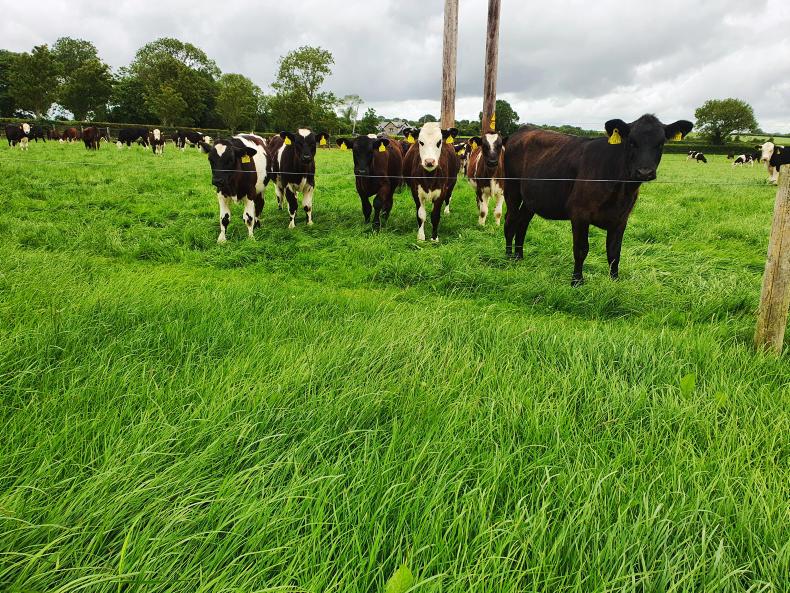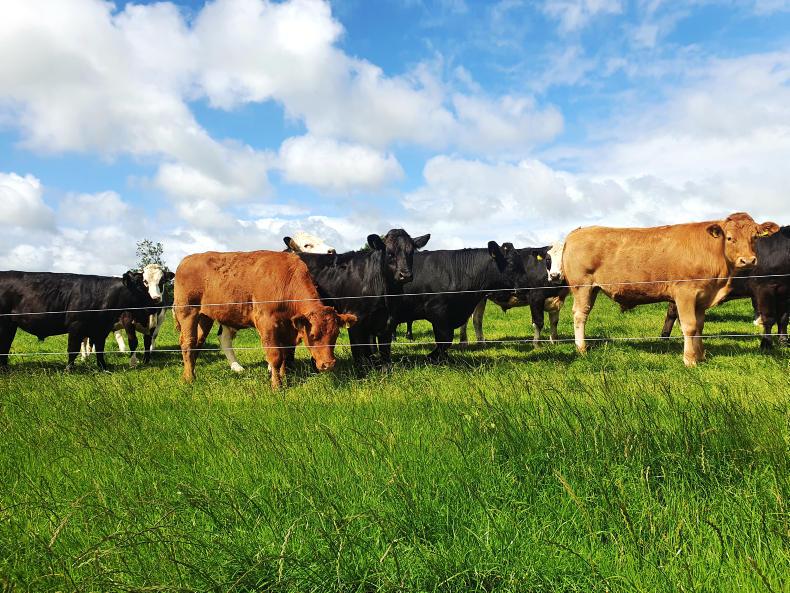The perfect level of moisture on the THRIVE demonstration farm has seen grass quality improve greatly across the farm as the seed head is finally removed from the sward.
There were still a couple of stronger paddocks as can be seen in the video that will have to be topped post-grazing.

Grass quality is excellent across the farm after receiving adequate moisture over the last fortnight.
We are now at a stage where we will be taking out paddocks again in the coming week to 10 days, as growth this week was 60kg DM/ha with a demand of 47kg DM/ha.
Now that growth has surpassed demand once again, it gives farmer John Hally the confidence to skip any stronger paddocks in the coming weeks and remove it as surplus grass.
John continues to spread a bag of cutsward/acre post-grazing to maintain quality and he is keen to replace any offtake of P and K from baled silage throughout the year.
There was no fertiliser spread on grazing ground throughout the majority of June due to the dry conditions.

The oldest batch of calves.
The majority of this year’s calves are in two batches and both are grazing lovely leafy swards at all times. The younger of the two batches continues to get 1kg/head/day of concentrate.
Seven calves remain on milk and will be weaned in the coming week. These are late-born calves and, in truth, they will struggle to hit target weights throughout the production system.
The yearling stock are also grazing almost-perfect conditions.
One group of heifers came out of a strong paddock while I was there on Monday. This was marked for topping that evening, as there was quite a bit of stem in it.
Bullying
Within one group of the yearling bullocks, they have started to pick on one Limousin for the last couple of weeks, which, as expected, has really affected his thrive.

The red Limousin on the left has been removed from the grazing group.
John took him out of the group and left him the other side of the wire grazing next to them for a few days to see if they would settle. However, they started on him once again when he was reintroduced to the group.
He is back out on his own again. However, we might try running him with a batch of heifers to see if he settles in with them.
The perfect level of moisture on the THRIVE demonstration farm has seen grass quality improve greatly across the farm as the seed head is finally removed from the sward.
There were still a couple of stronger paddocks as can be seen in the video that will have to be topped post-grazing.

Grass quality is excellent across the farm after receiving adequate moisture over the last fortnight.
We are now at a stage where we will be taking out paddocks again in the coming week to 10 days, as growth this week was 60kg DM/ha with a demand of 47kg DM/ha.
Now that growth has surpassed demand once again, it gives farmer John Hally the confidence to skip any stronger paddocks in the coming weeks and remove it as surplus grass.
John continues to spread a bag of cutsward/acre post-grazing to maintain quality and he is keen to replace any offtake of P and K from baled silage throughout the year.
There was no fertiliser spread on grazing ground throughout the majority of June due to the dry conditions.

The oldest batch of calves.
The majority of this year’s calves are in two batches and both are grazing lovely leafy swards at all times. The younger of the two batches continues to get 1kg/head/day of concentrate.
Seven calves remain on milk and will be weaned in the coming week. These are late-born calves and, in truth, they will struggle to hit target weights throughout the production system.
The yearling stock are also grazing almost-perfect conditions.
One group of heifers came out of a strong paddock while I was there on Monday. This was marked for topping that evening, as there was quite a bit of stem in it.
Bullying
Within one group of the yearling bullocks, they have started to pick on one Limousin for the last couple of weeks, which, as expected, has really affected his thrive.

The red Limousin on the left has been removed from the grazing group.
John took him out of the group and left him the other side of the wire grazing next to them for a few days to see if they would settle. However, they started on him once again when he was reintroduced to the group.
He is back out on his own again. However, we might try running him with a batch of heifers to see if he settles in with them.









 This is a subscriber-only article
This is a subscriber-only article










SHARING OPTIONS: